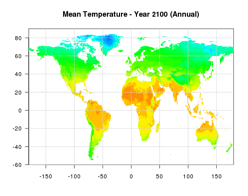Weather To Climate Learning Sequence

Focus:
Explore the concepts of weather and climate using local weather data and global climate data.
Rationale:
The goal of
this sequence is to provide students with a bridge between
the study of weather and the study of climate and global
climate change that is grounded in students' experience and
environment. The Weather to Climate Learning
Progression begins with an exploration of a long-term local
weather dataset from Daymet, which provides
daily climatological data from the Oak Ridge National
Laboratory Distributed Active Archive Center (ORNL DAAC). Depending on the level of
inquiry, students explore provided datasets or download and
prepare their own. They are then able to use Climate Change
Visualization Tools to compare their local findings with
future climate predictions at this location, and climate
patterns across the globe.
Part 1.
Find and explore local weather data using Excel (or a similar
spreadsheet tool).
Part 2. Use
the Climate Change Visualization Tools on the Student Climate
Data website to compare and contrast historical/current data
with future predictions, and local data with global data.
Background Resources:
**Climate Change: How do we know?
To
What Degree? video series
Short, engaging
videos that describe the science behind climate change
NASA's Global
Change Evidence
Overview of the
evidence for a changing climate.
**
What does a change in
global temperature mean?
Students are often underwhelmed by the degree of temperature
change predicted to occur in the next 100 years. To help them
understand, here are some bullet points from the EPA's
Climate Change FAQs.
"Changing the average global temperature by even a degree or
two can lead to serious consequences around the globe. For
about every 2°F of warming [only 1°C!] we can expect to see:
- 5-15% reductions in the yields of crops as currently grown
- 3-10% increases in the amount of rain falling during the heaviest precipitation events, which can increase flooding risks
- 5-10% decreases in stream flow in some river basins, including the Arkansas and the Rio Grande
- 200-400% increases in the area burned by wildfire in parts of the western United States
Global average
temperatures have increased more than 1.4 degrees Fahrenheit
over the last 100 years. Many of the extreme precipitation and
heat events that we have seen in recent years are consistent
with what we would expect given this amount of warming.
Scientists project that the Earth's average temperatures will
rise between 2 and 12 degrees Fahrenheit by 2100."
